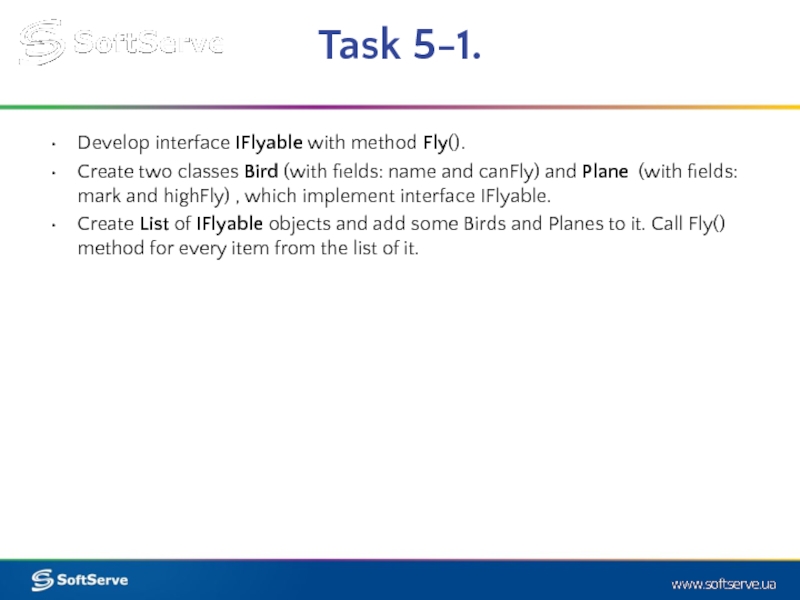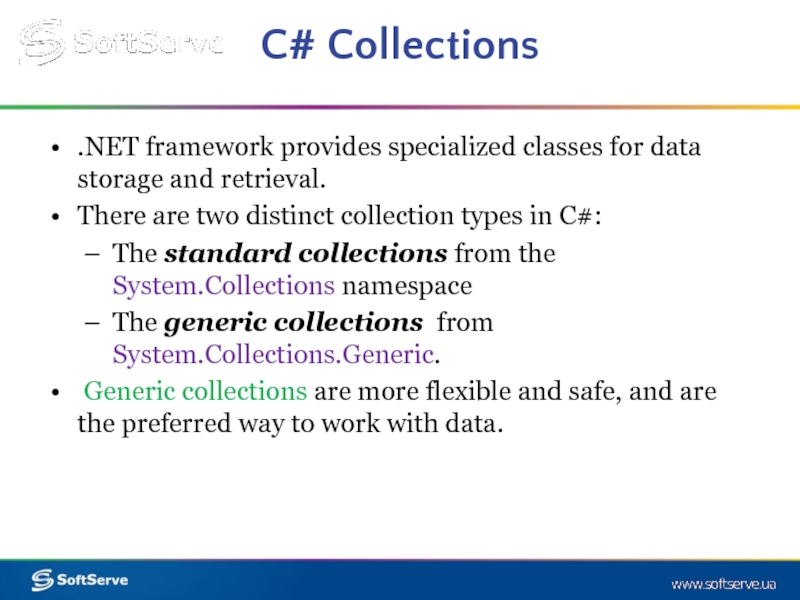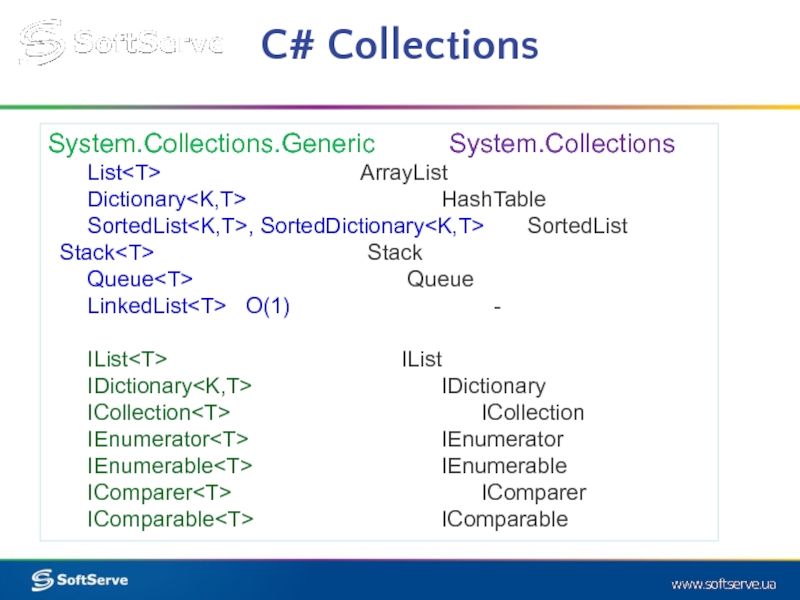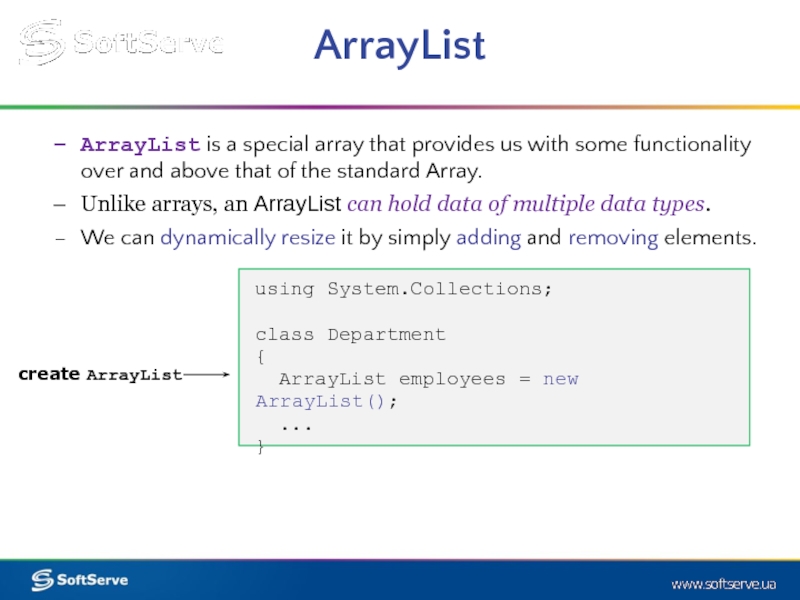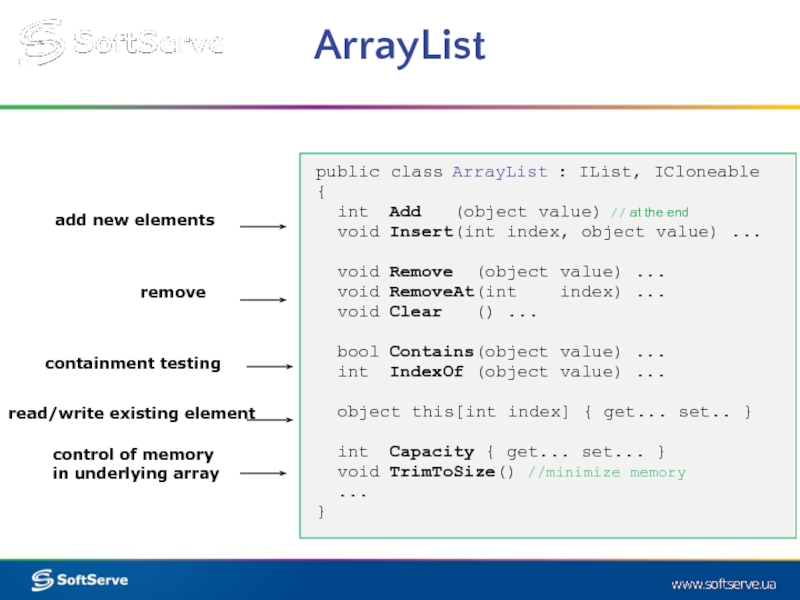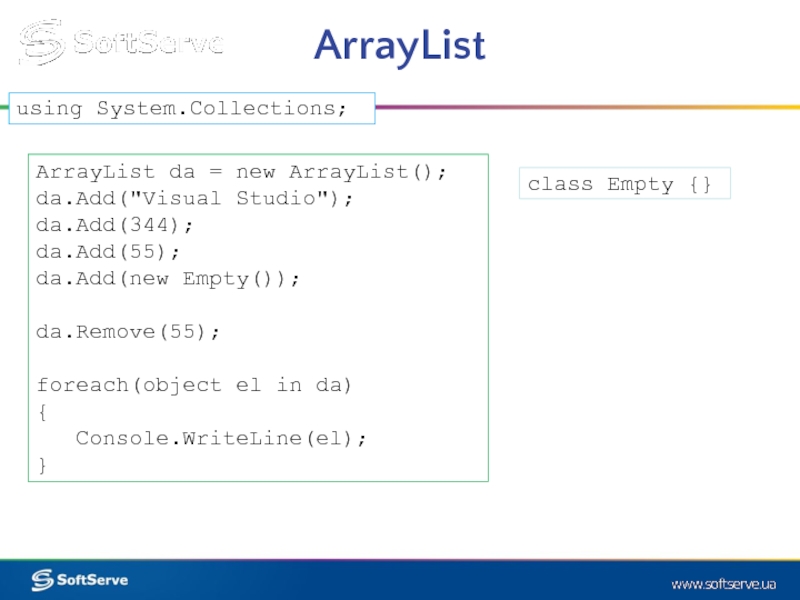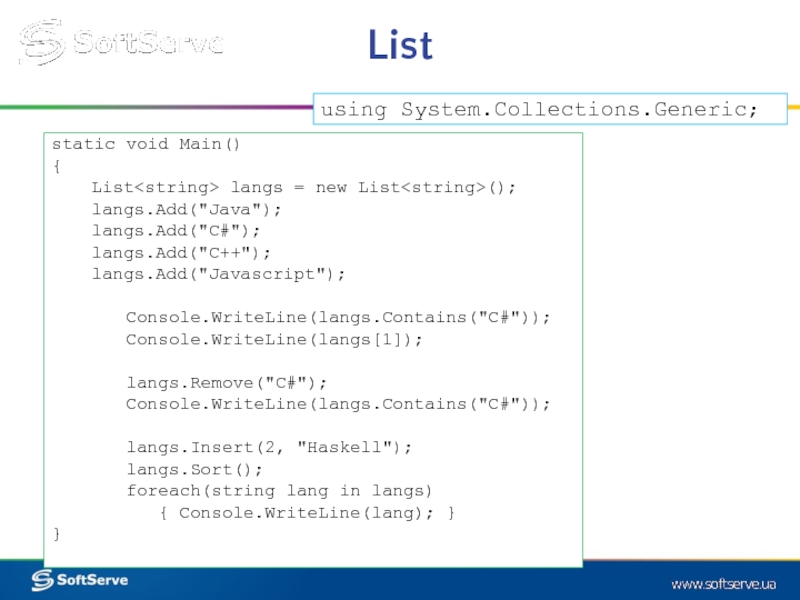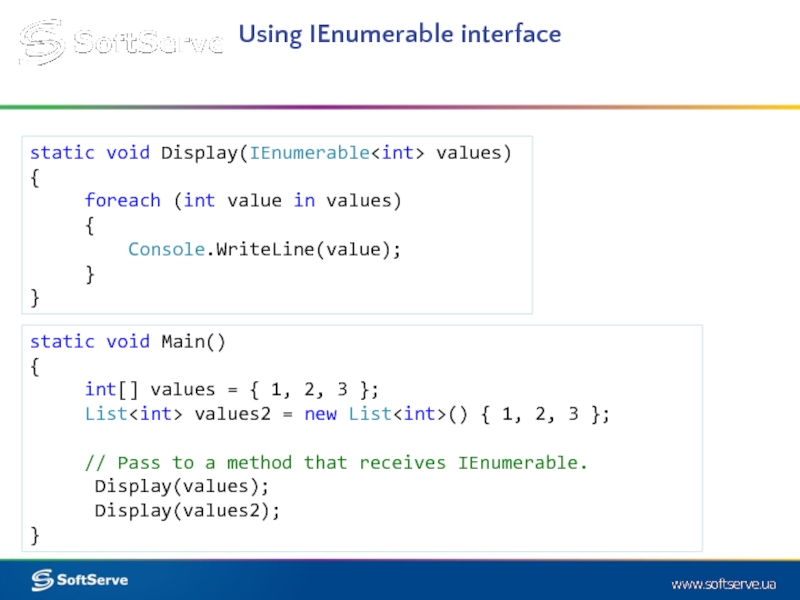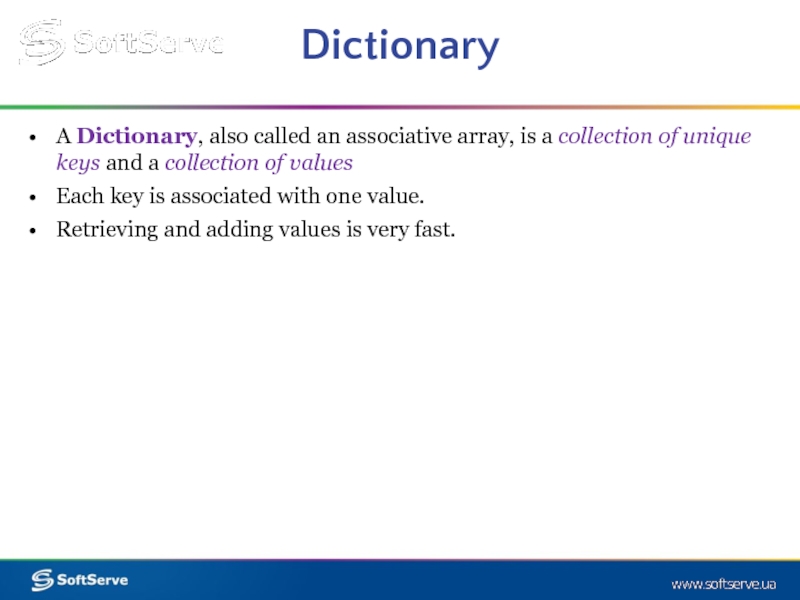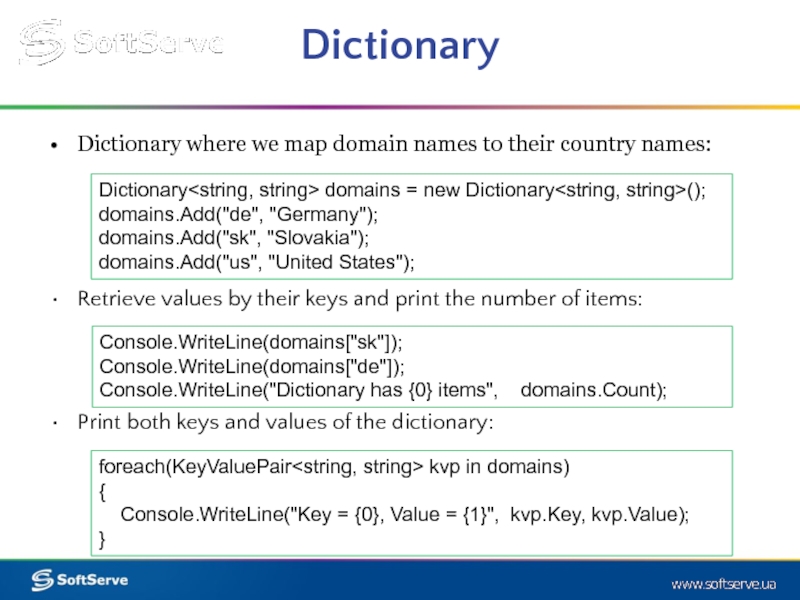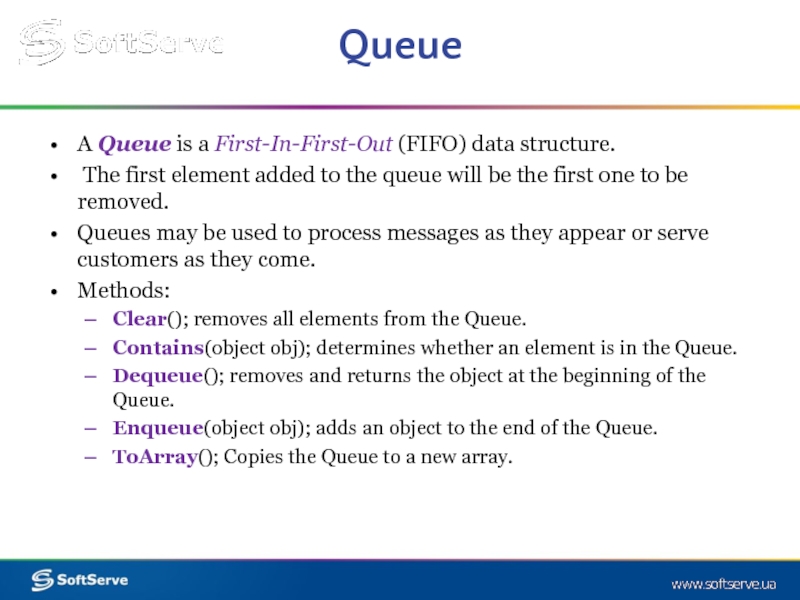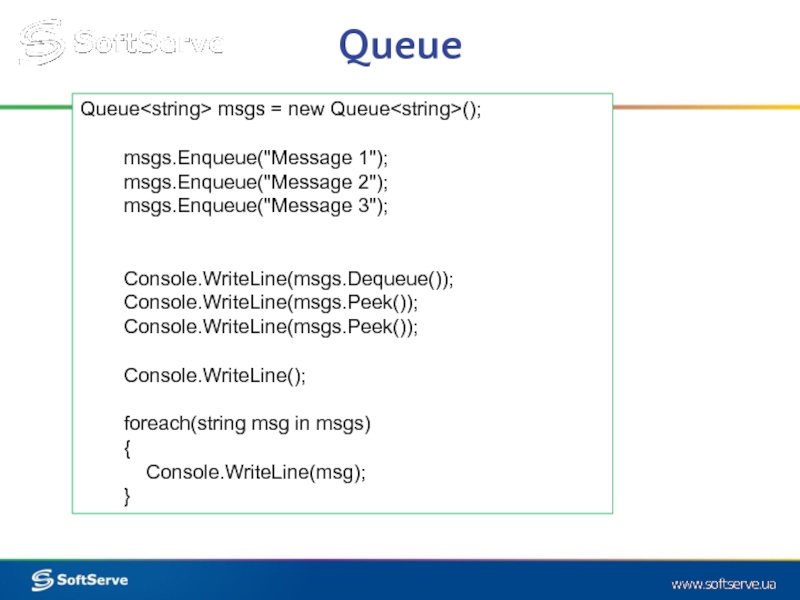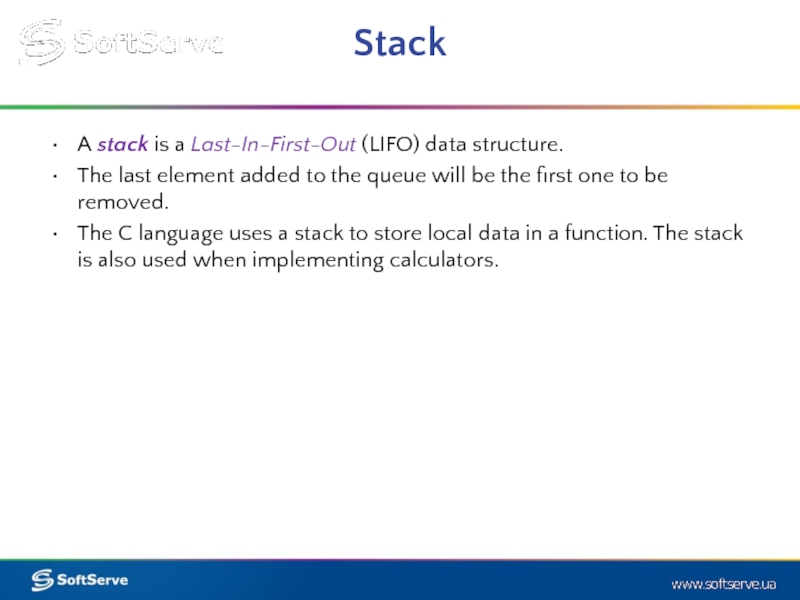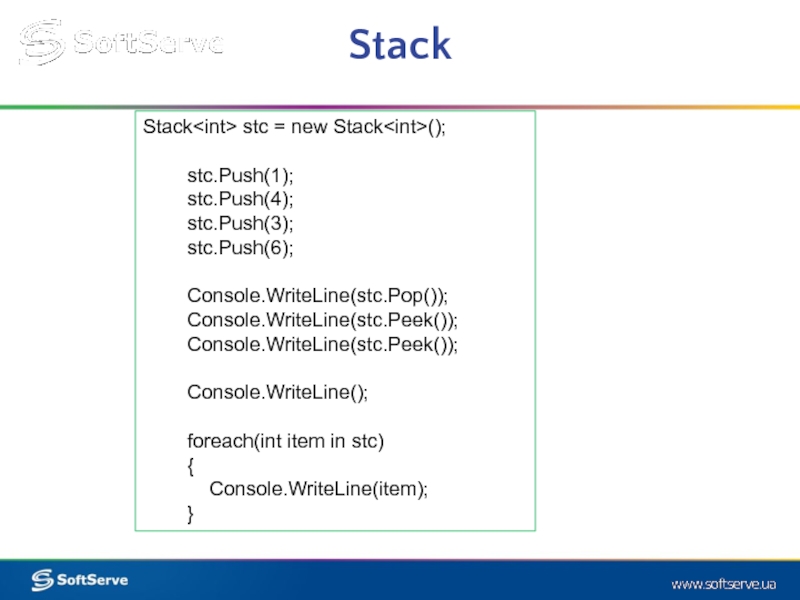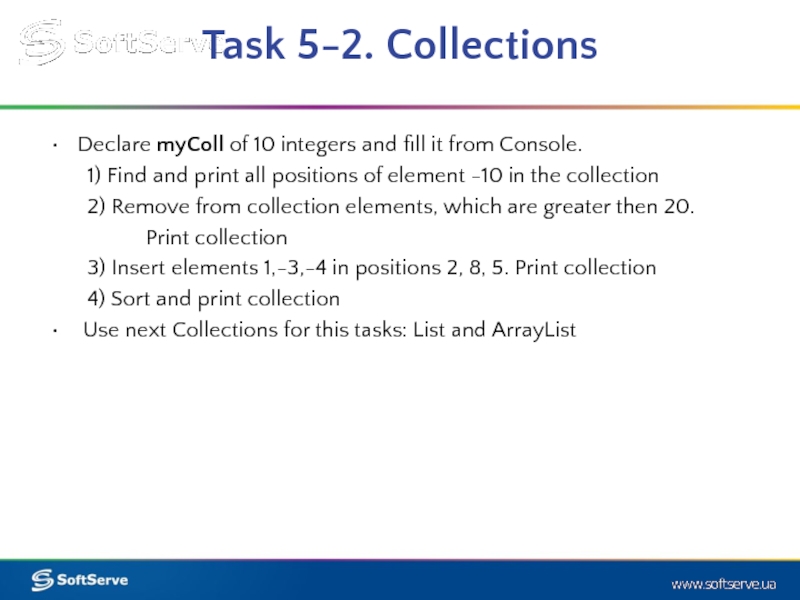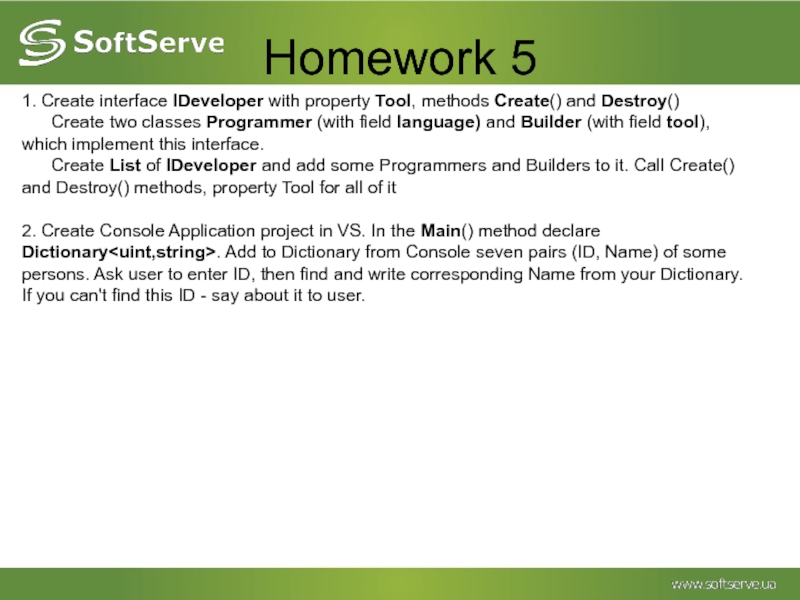- Главная
- Разное
- Дизайн
- Бизнес и предпринимательство
- Аналитика
- Образование
- Развлечения
- Красота и здоровье
- Финансы
- Государство
- Путешествия
- Спорт
- Недвижимость
- Армия
- Графика
- Культурология
- Еда и кулинария
- Лингвистика
- Английский язык
- Астрономия
- Алгебра
- Биология
- География
- Детские презентации
- Информатика
- История
- Литература
- Маркетинг
- Математика
- Медицина
- Менеджмент
- Музыка
- МХК
- Немецкий язык
- ОБЖ
- Обществознание
- Окружающий мир
- Педагогика
- Русский язык
- Технология
- Физика
- Философия
- Химия
- Шаблоны, картинки для презентаций
- Экология
- Экономика
- Юриспруденция
Interfaces. C# Collections презентация
Содержание
- 1. Interfaces. C# Collections
- 2. AGENDA Interface declaration Interface implementation Built-in .Net
- 3. Interface declaration modificator opt
- 4. Interface declaration interface IMyInterface { void
- 5. Interface Implementation interface IFighter {
- 6. Any class or struct that implements the
- 7. interface IPerson { string Name {
- 8. FCL .Net Interfaces IEnumerable:
- 9. .Net Library Interfaces public interface IComparable { Int32 CompareTo(T other); }
- 10. class Doctor:IComparable { int CompareTo(Doctor
- 11. Task 5-1. Develop interface IFlyable with method
- 12. C# Collections .NET framework provides specialized classes
- 13. C# Collections System.Collections.Generic
- 14. ArrayList ArrayList is a special array that
- 15. ArrayList public class ArrayList : IList,
- 16. ArrayList ArrayList da = new ArrayList();
- 17. List List is a strongly typed list of
- 18. List static void Main() {
- 19. Using IEnumerable interface static void Display(IEnumerable values)
- 20. Dictionary A Dictionary, also called an associative array,
- 21. Dictionary Dictionary where we map domain names
- 22. Queue A Queue is a First-In-First-Out (FIFO)
- 23. Queue Queue msgs = new Queue();
- 24. Stack A stack is a Last-In-First-Out (LIFO) data
- 25. Stack Stack stc = new Stack();
- 26. Task 5-2. Collections Declare myColl of 10
- 27. Homework 5 1. Create interface IDeveloper with
Слайд 2AGENDA
Interface declaration
Interface implementation
Built-in .Net interfaces
Task1
C# Collections
Task 2
Слайд 3Interface declaration
modificator opt interface INameOfInterface: listOfInterfaces opt
{
//declaration of interface members
}
Interface Includes only declaration of method, properties, events, indexers
Interface can't contain constants, fields, operators, instance constructors, destructors, or types.
Interface members are automatically public, and they can't include any access modifiers.
Interface members can't be static.
An interface contains definitions for a group of related functionalities that a class or a struct can implement
Слайд 4Interface declaration
interface IMyInterface
{
void Process(int arg1, double arg2);
float this [int
string Name { get; set; }
event MouseEventHandler Mouse;
}
Слайд 5
Interface Implementation
interface IFighter
{
void Punch(int side);
void Kick (int side);
void
}
class Soldier : IFighter
{
public void Punch(int side)
{
Move(arms[side], Forward);
}
public void Kick (int side)
{
Move(legs[side], Forward);
}
public void Block()
{
Move(arms[Left ], Up);
Move(arms[Right], Up);
}
public void Move(Arm a,Direction d)
{
…
}
public void Move(Leg l,Direction d)
{
…
}
}
IFighter f = new Soldier();
f.Punch(Left);
f.Kick(Right);
f.Block();
IFighter s= new Dragon();
s.Punch(Left);
s.Kick(Right);
s.Block();
...
class Dragon : IFighter
{
public void Punch(int side)
{
Move(tail, side);
}
public void Kick (int side)
{
Move(legs[side], Forward);
}
public void Block()
{
Move(legs[Left ], Up);
Move(tail, Up);
}
}
Слайд 6Any class or struct that implements the interface must implement all
By using interfaces, we may include behavior from multiple sources in a class.
It is important in C# because the language doesn't support multiple inheritance of classes.
We must use an interface for simulating inheritance for structs, because they can't actually inherit from another struct or class.
Interface Implementation
Слайд 7interface IPerson
{
string Name { get; set; }
string Introduce();
}
interface IFighter
{
void Kick (int side);
void Block();
}
Interface Implementation
Слайд 8FCL .Net Interfaces
IEnumerable:
The IEnumerable interface allows foreach-loops on
IDisposable:
Provides a mechanism for releasing unmanaged resources
ICollection:
Defines methods to manipulate generic collections.
Слайд 10class Doctor:IComparable
{
int CompareTo(Doctor other)
{
return salary-other.salary;
}
...
}
public
{
Doctor [] doctors= new Doctor [5];
//… input doctors
Array.Sort(doctors);
Слайд 11Task 5-1.
Develop interface IFlyable with method Fly().
Create two classes Bird (with
Create List of IFlyable objects and add some Birds and Planes to it. Call Fly() method for every item from the list of it.
Слайд 12C# Collections
.NET framework provides specialized classes for data storage and retrieval.
There
The standard collections from the System.Collections namespace
The generic collections from System.Collections.Generic.
Generic collections are more flexible and safe, and are the preferred way to work with data.
Слайд 13C# Collections
System.Collections.Generic System.Collections
List
Dictionary
SortedList
Stack
Queue
LinkedList
IList
IDictionary
ICollection
IEnumerator
IEnumerable
IComparer
IComparable
Слайд 14ArrayList
ArrayList is a special array that provides us with some functionality
Unlike arrays, an ArrayList can hold data of multiple data types.
We can dynamically resize it by simply adding and removing elements.
using System.Collections;
class Department
{
ArrayList employees = new ArrayList();
...
}
create ArrayList
Слайд 15ArrayList
public class ArrayList : IList, ICloneable
{
int Add (object
void Insert(int index, object value) ...
void Remove (object value) ...
void RemoveAt(int index) ...
void Clear () ...
bool Contains(object value) ...
int IndexOf (object value) ...
object this[int index] { get... set.. }
int Capacity { get... set... }
void TrimToSize() //minimize memory
...
}
control of memory
in underlying array
add new elements
remove
containment testing
read/write existing element
Слайд 16ArrayList
ArrayList da = new ArrayList();
da.Add("Visual Studio");
da.Add(344);
da.Add(55);
da.Add(new Empty());
da.Remove(55);
foreach(object el in da)
{
Console.WriteLine(el);
}
class Empty {}
using System.Collections;
Слайд 17List
List is a strongly typed list of objects that can be accessed
It can be found under System.Collections.Generic namespace
Слайд 18List
static void Main()
{
List langs = new List();
langs.Add("Java");
langs.Add("C#");
langs.Add("C++");
langs.Add("Javascript");
Console.WriteLine(langs.Contains("C#"));
Console.WriteLine(langs[1]);
langs.Remove("C#");
Console.WriteLine(langs.Contains("C#"));
langs.Insert(2, "Haskell");
langs.Sort();
foreach(string lang in langs)
{ Console.WriteLine(lang); }
}
using System.Collections.Generic;
Слайд 19Using IEnumerable interface
static void Display(IEnumerable values)
{
foreach (int value
{
Console.WriteLine(value);
}
}
static void Main()
{
int[] values = { 1, 2, 3 };
List
// Pass to a method that receives IEnumerable.
Display(values);
Display(values2);
}
Слайд 20Dictionary
A Dictionary, also called an associative array, is a collection of unique
Each key is associated with one value.
Retrieving and adding values is very fast.
Слайд 21Dictionary
Dictionary where we map domain names to their country names:
Retrieve values
Print both keys and values of the dictionary:
Dictionary Console.WriteLine(domains["sk"]); foreach(KeyValuePair
domains.Add("de", "Germany");
domains.Add("sk", "Slovakia");
domains.Add("us", "United States");
Console.WriteLine(domains["de"]);
Console.WriteLine("Dictionary has {0} items", domains.Count);
{
Console.WriteLine("Key = {0}, Value = {1}", kvp.Key, kvp.Value);
}
Слайд 22Queue
A Queue is a First-In-First-Out (FIFO) data structure.
The first element
Queues may be used to process messages as they appear or serve customers as they come.
Methods:
Clear(); removes all elements from the Queue.
Contains(object obj); determines whether an element is in the Queue.
Dequeue(); removes and returns the object at the beginning of the Queue.
Enqueue(object obj); adds an object to the end of the Queue.
ToArray(); Copies the Queue to a new array.
Слайд 23Queue
Queue msgs = new Queue();
msgs.Enqueue("Message 1");
msgs.Enqueue("Message 3");
Console.WriteLine(msgs.Dequeue());
Console.WriteLine(msgs.Peek());
Console.WriteLine(msgs.Peek());
Console.WriteLine();
foreach(string msg in msgs)
{
Console.WriteLine(msg);
}
Слайд 24Stack
A stack is a Last-In-First-Out (LIFO) data structure.
The last element added to
The C language uses a stack to store local data in a function. The stack is also used when implementing calculators.
Слайд 25Stack
Stack stc = new Stack();
stc.Push(1);
stc.Push(3);
stc.Push(6);
Console.WriteLine(stc.Pop());
Console.WriteLine(stc.Peek());
Console.WriteLine(stc.Peek());
Console.WriteLine();
foreach(int item in stc)
{
Console.WriteLine(item);
}
Слайд 26Task 5-2. Collections
Declare myColl of 10 integers and fill it from
1) Find and print all positions of element -10 in the collection
2) Remove from collection elements, which are greater then 20.
Print collection
3) Insert elements 1,-3,-4 in positions 2, 8, 5. Print collection
4) Sort and print collection
Use next Collections for this tasks: List and ArrayList
Слайд 27Homework 5
1. Create interface IDeveloper with property Tool, methods Create() and
Create two classes Programmer (with field language) and Builder (with field tool), which implement this interface.
Create List of IDeveloper and add some Programmers and Builders to it. Call Create() and Destroy() methods, property Tool for all of it
2. Create Console Application project in VS. In the Main() method declare Dictionary

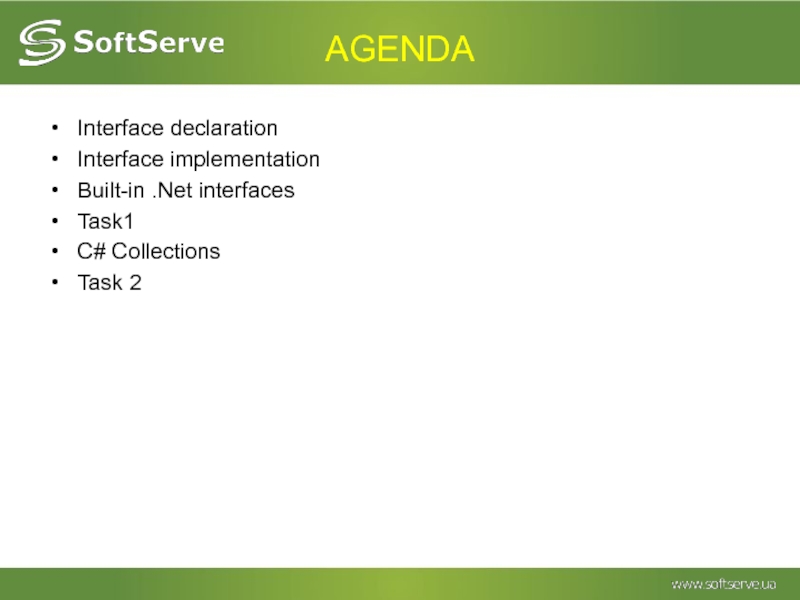
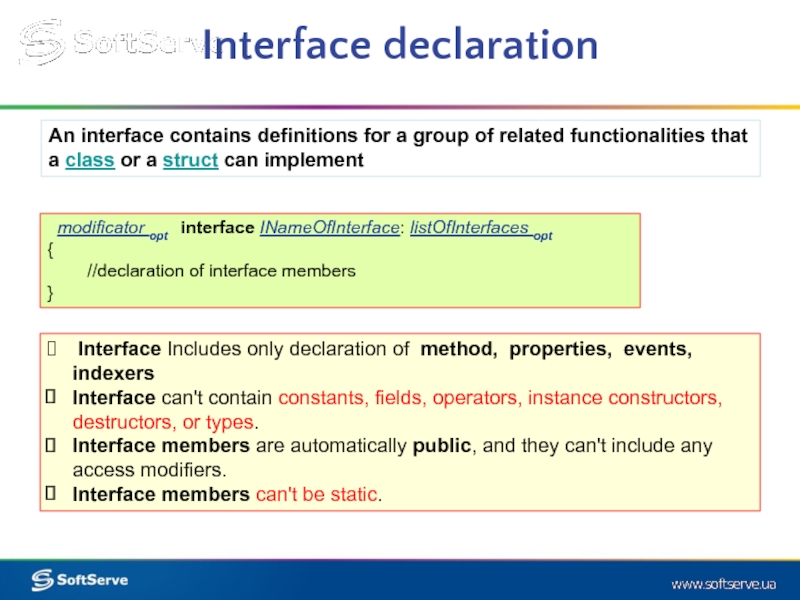
![Interface declarationinterface IMyInterface{ void Process(int arg1, double arg2); float this [int index] { get; set;](/img/tmb/3/285878/817293627f2c81c68231de6ec2fc1361-800x.jpg)
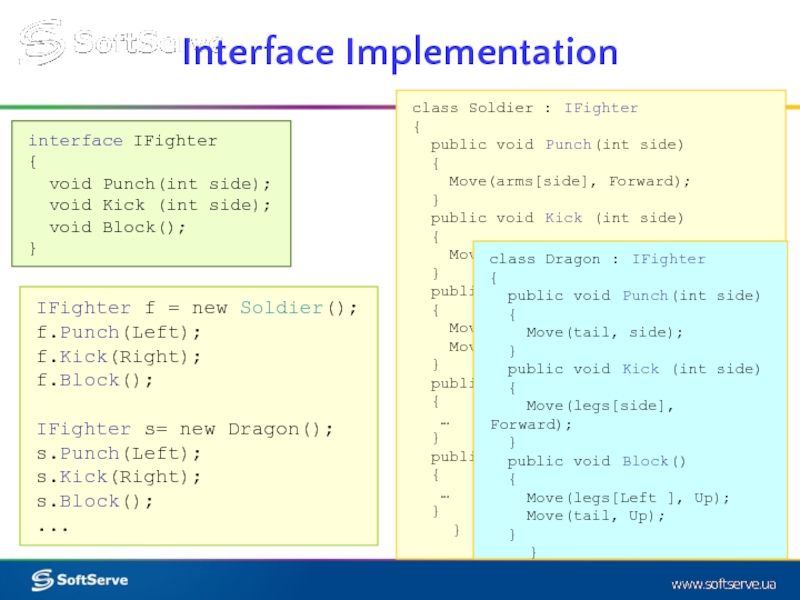
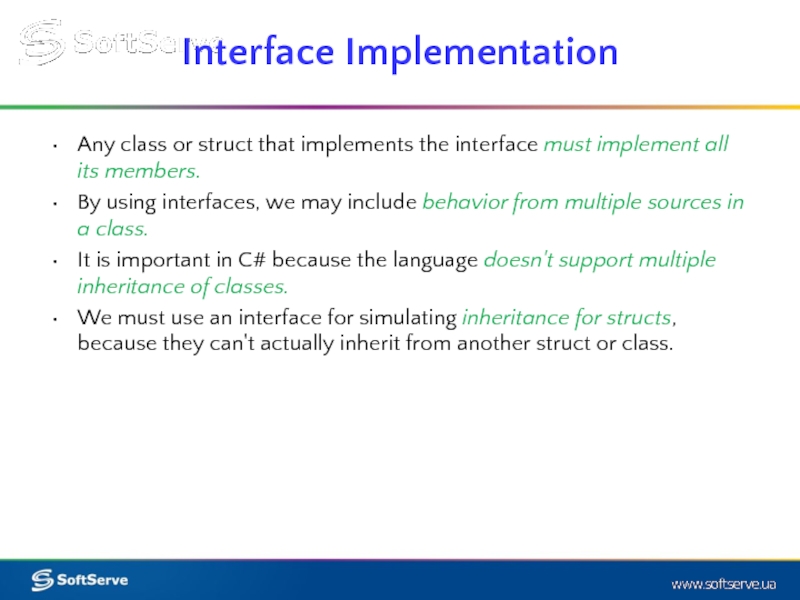
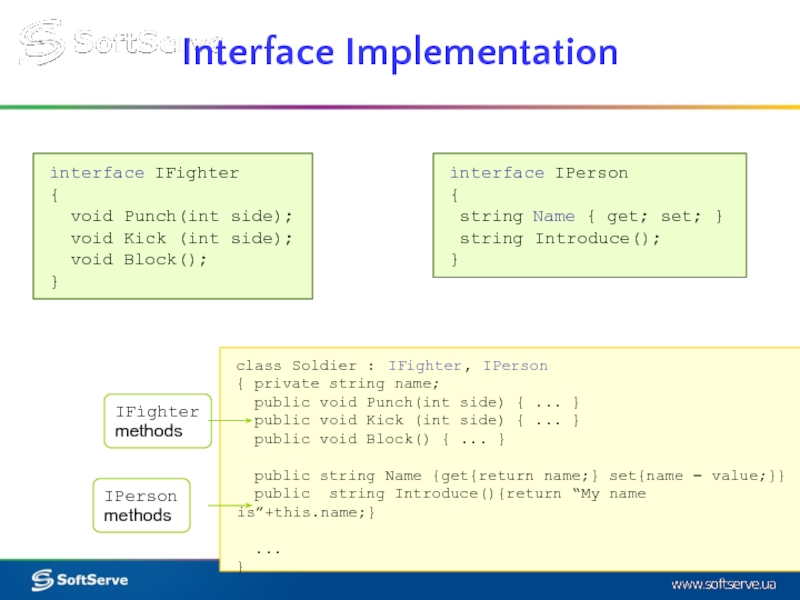
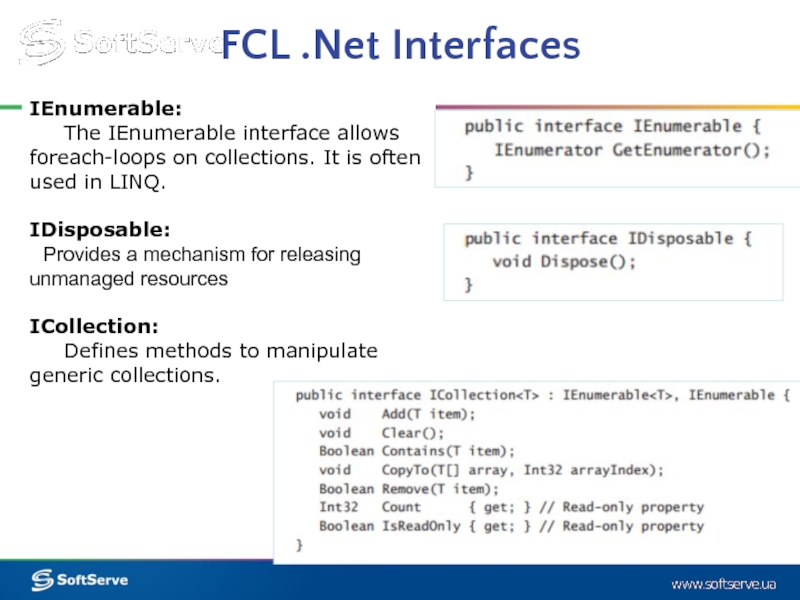
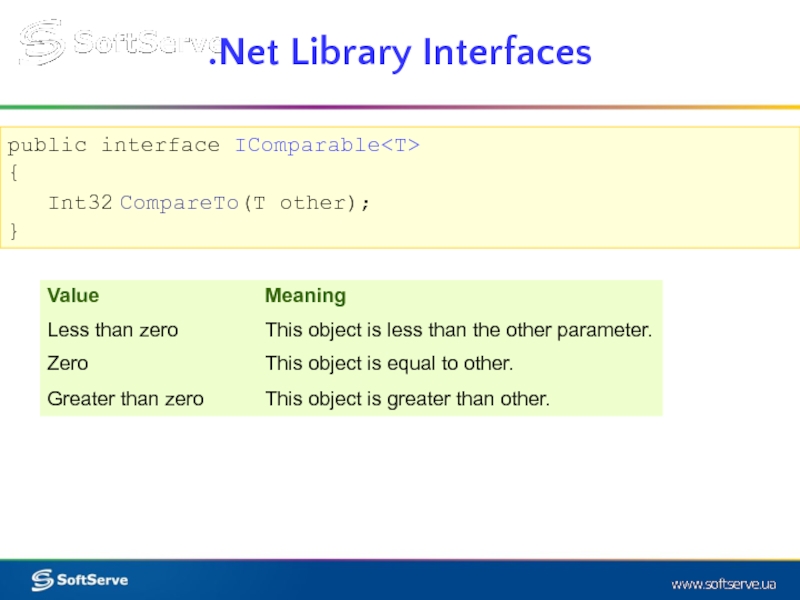
![class Doctor:IComparable{ int CompareTo(Doctor other){ return salary-other.salary;}... }public static void Main(){ Doctor [] doctors= new](/img/tmb/3/285878/0c1b9789e159e4025cee762d1ab53225-800x.jpg)
